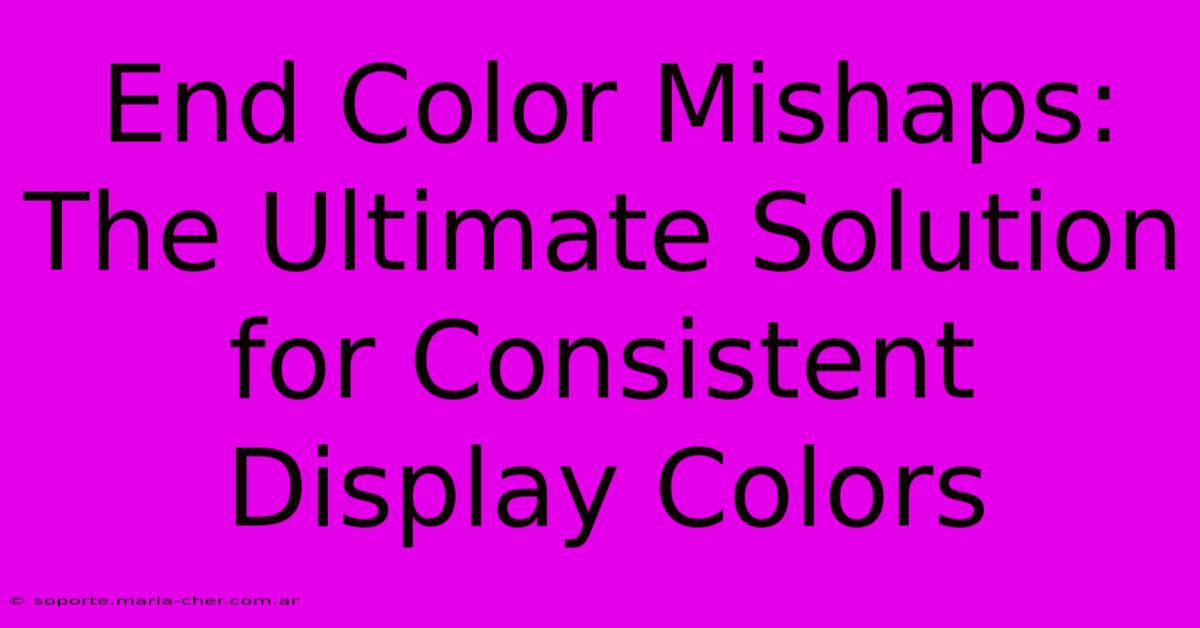End Color Mishaps: The Ultimate Solution For Consistent Display Colors

Table of Contents
End Color Mishaps: The Ultimate Solution for Consistent Display Colors
Are you tired of color inconsistencies plaguing your design projects? Does your carefully crafted artwork look drastically different on different screens? You're not alone. Achieving consistent display colors across various devices and platforms is a common challenge for designers, photographers, and anyone working with digital imagery. But fear not! This comprehensive guide will arm you with the knowledge and techniques to conquer color mishaps and achieve the vibrant, accurate colors you envision.
Understanding the Root of the Problem: Color Profiles and Gamuts
The core issue behind inconsistent display colors lies in the differences between color profiles and color gamuts. A color profile is a set of data that describes how a specific device (monitor, printer, etc.) reproduces color. A color gamut, on the other hand, represents the range of colors a device can display or reproduce. Different devices have different gamuts, meaning they can't display the entire spectrum of colors.
Why Color Profiles Matter:
Think of a color profile as a translator. It helps your computer understand how your monitor interprets colors, allowing for a more accurate representation of the intended colors. Without proper color profile management, your monitor might interpret colors differently than the intended colors in your digital file.
Gamut Differences: The Wider the Better (But Not Always!)
A wider gamut means a device can display a broader range of colors. However, a wider gamut doesn't automatically guarantee perfect color accuracy. If your monitor has a wide gamut, but doesn't have a properly calibrated color profile, you'll still encounter inconsistencies.
The Ultimate Solution: Calibrating Your Monitor
The most effective way to ensure consistent display colors is to calibrate your monitor. Calibration involves adjusting your monitor's settings to match a standard color space, such as sRGB or Adobe RGB. This ensures that the colors you see on your screen are as close as possible to the colors intended by the creator of the image or design.
How to Calibrate Your Monitor:
-
Use a colorimeter: A colorimeter is a hardware device that measures the actual colors displayed on your screen and adjusts the settings accordingly. This offers the most accurate calibration. Popular brands include Datacolor and X-Rite.
-
Use calibration software: Many software solutions offer monitor calibration functionality. These often utilize your computer's built-in sensors, providing a less precise but still effective calibration. Examples include DisplayCAL and Argyll CMS.
-
Manual Calibration: While less precise, you can manually adjust brightness, contrast, and color balance settings. However, this method requires a good eye and understanding of color theory.
Beyond Calibration: Additional Tips for Consistent Colors
Even with a perfectly calibrated monitor, other factors can influence color accuracy. Here are additional steps to ensure consistent color display:
Working in a Consistent Color Space:
Choose a color space and stick with it throughout your workflow. sRGB is a widely used color space suitable for web design and general image viewing. Adobe RGB offers a wider gamut, ideal for professional photography and printing.
Using Color Management Software:
Software like Adobe Photoshop, Lightroom, and Illustrator includes robust color management features. Ensure these are properly configured to utilize your monitor's color profile and the chosen color space.
Regular Calibration:
Monitor calibration isn't a one-time event. Over time, your monitor's settings can drift. Regular calibration (every few months) helps maintain color accuracy.
Consider Your Viewing Environment:
Ambient lighting can affect how colors appear on your screen. Minimize glare and ensure your workspace has consistent lighting conditions.
Conclusion: Consistent Colors, Consistent Results
Achieving consistent display colors requires a multifaceted approach, but the rewards are significant. By understanding color profiles, gamuts, and implementing the techniques outlined above – particularly monitor calibration – you can eliminate color mishaps and ensure your digital work is consistently represented across all platforms. This will lead to improved design accuracy, more professional results, and ultimately, a more satisfying creative process. Remember, consistent colors lead to consistent results, helping you deliver exactly the vision you have for your projects.

Thank you for visiting our website wich cover about End Color Mishaps: The Ultimate Solution For Consistent Display Colors. We hope the information provided has been useful to you. Feel free to contact us if you have any questions or need further assistance. See you next time and dont miss to bookmark.
Featured Posts
-
Step By Step Guide To Best Of Signs Login Empower Your Smart Lifestyle
Feb 10, 2025
-
Elevate Your Brand The Power Of A Ceo Signature Block That Commands Respect
Feb 10, 2025
-
Transform Your Designs With The Power Of Koulen Font Match
Feb 10, 2025
-
Step Into The Disney Universe Find Your Ideal Career In Anaheim
Feb 10, 2025
-
The Sword Of Justice The King Of Swords Unwavering Stand
Feb 10, 2025
